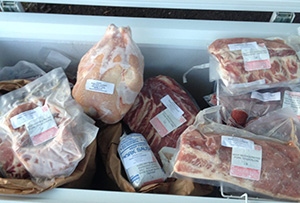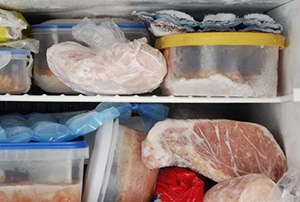Meat storage is an essential element of a responsible prepper’s plans. You don’t want to discover that your procedures involved mistakes during an emergency.
Both newbies and veterans slip up now and then, however.
We discuss the oversights that may lead to waste and the rules that apply when you employ the freezing and freeze-drying options.
The Refrigerator/Freezer – A Modern Age Luxury: a freezer will keep your meat 100 percent wholesome, but taste and quality may suffer the longer it stays in there.
Here are the top mistakes when freezing meat:
Buying Too Much for the Available Space
Work out a strategy based on your storage capacity, family needs, and budget before purchasing chicken, steak, beef, fish, and other meats.
Freezing Meats That Are No Longer Fresh
Freeze high-quality cuts that are at their best. Trim the surplus fat beforehand and remove the bones to save space. Consider padding sharp edges to prevent freezer wrap damage.
Related: How to Slaughter and Field Dress a Cow for Year-Round Meat
Not Knowing the Temperature for Storing Meat

Storing food at a constant zero degrees Fahrenheit keeps it safe because mold, yeast, and bacteria become inactive at that temperature.
Not Checking Temperature Settings
Learn how and set your deep-freeze to the correct temperature so it can do its job – 32 degrees Fahrenheit or less.
Not Paying Enough Attention to Hygiene
Prevent harmful germs from contaminating your food. Ensure that your hands, knives, countertops, and cutting boards are spotless before you start cutting.
Forgetting That Light, Air, Heat, And Moisture Spoil Food Quickly
Stop the process in its tracks, slow down the enzyme activity, and preserve the flavor, texture, and color by utilizing moisture and vapor-resistant freezer material so the meat and poultry will not dry out.
Keeping the Meat in the Refrigerator Too Long
 Lock in the nutrients and flavor to retain its quality for longer. The US Department of Agriculture recommends that you keep seafood, poultry, or raw ground meats in the fridge for two days at most.
Lock in the nutrients and flavor to retain its quality for longer. The US Department of Agriculture recommends that you keep seafood, poultry, or raw ground meats in the fridge for two days at most.
Related: How Long Can You Store Food In The Freezer? (Infographic)
Delaying Leftover Freezing
Place cooked leftovers in the fridge-freezer while it’s as fresh as possible. Leaving it on the counter for long periods compromises quality.
Re-Freezing
Moisture content is vital since you will lose taste and quality when you defrost. Leaving rations out too long affects safety. Only re-freeze if you can do so quickly.
Not Wrapping Up Your Food Adequately
 Shop packaging will not protect your steak.
Shop packaging will not protect your steak.
Wrap your food closely in an extra layer of wax paper or aluminum foil and seal it in an airtight container, Mylar, or zip-lock freezer bag.
Try to eliminate all air and leave enough space between packages for air circulation.
An Airtight Container May Still Have Air Inside
No more air can get in, but what to do to remove the air trapped inside? Place the sealed container in boiling water to destroy harmful organisms. Some of the air will turn into steam and escape.
Being Inattentive to Freezer Burn
Ask the butcher to cut, package, and freeze the beef when you buy large quantities at the same time.
A slow home freezing process may result in ice crystal formation, which contributes to freezer burn and may result in meat juice loss when you defrost.
Related: How to Keep a Slaughtered Animal From Spoiling by Eating it in the Right Order
Believing That You Can Freeze All Meats for the Same Amount of Time
- Freeze previously canned seafood, lunch meats, smoked fish, cooked ham, hot dogs, sausages, and bacon for one to two months.
 The following should last safely for two to four months: frozen cooked casseroles, stewing meats, meat broth, soups, fresh oysters, mussels, clams, shellfish, fatty fish, chicken nuggets, chicken pieces, fried chicken, raw hamburger, venison, offal, beef, turkey, and pork.
The following should last safely for two to four months: frozen cooked casseroles, stewing meats, meat broth, soups, fresh oysters, mussels, clams, shellfish, fatty fish, chicken nuggets, chicken pieces, fried chicken, raw hamburger, venison, offal, beef, turkey, and pork.- Clams, squid, scallops, fresh shrimp, crab, lobster, cooked fish, lean fish, cooked poultry, whole turkey and chicken, beef roasts, raw beef, pork roasts, uncooked pork, veal, and lamb should last four to six months.
A Lack of Planning
Make meal preparation as easy as possible. Wrap and freeze portions separately if you are not going to use everything. Divide ground meat into patties or meatballs. Trimmed and pre-portioned cuts save time and thaw more quickly.
Defrosting at Room Temperature
Meat decays quickly once thawed. Defrost it inside the refrigerator or in cold water rather than on the kitchen counter. Bacteria start growing at between 40 and 140 degrees Fahrenheit.
Putting Hot Food in the Freezer
Cool cooked meat down to room temperature before freezing it to preserve texture and quality. Prevent other foods in the compartment from cooling down.
 Struggling to Separate Stuck-Together Foods
Struggling to Separate Stuck-Together Foods
Put a double layer of waxed paper between chicken pieces, chops, and ground meat patties to make your life easier.
Related: The Ultimate Chicken Meat Processing Guide for Preppers
Not Keeping Track of What it is or How Long it’s Been There
Label and date your food. You do not want to guess as you need to know by when to use it to prevent wastage. Eat the food that will expire soon first.
What About Power Cuts?
What to do if there are power cuts and the refrigerator stops working?
Enjoy Freeze Dried Meats
Stock up on pre-packaged flash-dried meats. Unopened flash-frozen fare remains edible for up to 25 years. Stockpile enough drinking water to rehydrate frozen meat in warm or hot water – it only takes in the moisture it needs – and cook as usual.
Use Your Freeze Dryer
A freeze dryer does most of the work.

Slice your meat up and place the pieces on the tray inside. The appliance creates a vacuum around the provisions by dropping the temperature inside to approximately 50 degrees below Fahrenheit. Then the inside of the freezer warms up to convert the water into vapor, thus removing the moisture.
Heat-seal the frozen, dried meat in Mylar bags. They protect against moisture and oxygen and are available with oxygen absorber packs.
Related: How To Repackage Foods in Mylar Bags With Oxygen Absorbers For Long Term Survival
Prepare yourself for a power outage – as you would for a natural disaster – whether it lasts for days, weeks, or months. You will be much more comfortable if you are ready for anything.
Plan for a water supply collapse because your electric-powered pump or purification station does not work. Store water in case there is nothing in your faucets and stock up on the appropriate requirements to purify collected water. Each person will need at least one gallon per day and animals should not be discounted.
Consider canning, salting, dehydration, and smoking to preserve your meat and be all set for electricity interruptions. Accumulate more than one week’s supply of non-perishable foods such as dried and canned beans, dried and canned vegetables and fruits, grains, soups, granola and protein bars, nuts and seeds, nut butter, and shelf-stable or non-dairy milk.
Consider acquiring batteries, a crank-powered, diesel or gasoline generator, or solar panels. They all have pros and cons but will make life easier during a power outage.

No comments:
Post a Comment